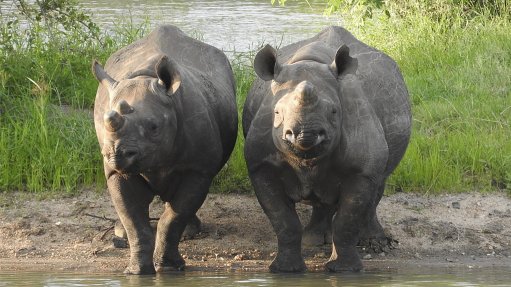
Nature conservation organisation, the International Union for Conservation of Nature (IUCN), reports that the world population of black rhino has risen from about 2 500 in the 1990s to 5 600.
Independent conservation organisation, the World Wide Fund for Nature (WWF) attributes some of that increase to its Black Rhino Range Expansion Project (BRREP), which was started in 2003 by “far-sighted” conservationists who saw the need to create new black rhino populations on large areas of good habitat.
The BRREP is run in partnership with Ezemvelo KwaZulu-Natal Wildlife and the Eastern Cape Parks and Tourism Agency, as well as various private and community landowners.
The project works by creating new populations of rhino by moving founders, of up to 25 black rhino at a time, onto properties large enough to maintain a significant population.
Often this involves neighbouring properties removing internal fences to create larger, unfettered reserves. There are 13 BRREP-created populations to date, on a total of more than 300 000 ha of land.
“It is great to see nearly two decades of hard work on behalf of black rhino paying off,” comments WWF BRREP head Dr Jacques Flamand.
He adds that BRREP sites now have 256 black rhino on them, with many of the rhino reproducing over a short period of time. “We had seven calves, born on four different sites, over the Christmas period.”
In addition, Flamand notes that most of the BRREP reserves had experienced a year of good rain. “We hope this leads to even more calves next year.”
In 2019, half of BRREP sites reached the 5% yearly growth target set by provincial conservation authorities. Black rhino numbers in the game reserves from which they were removed to create those populations, are also increasing consistently, as a result of consistently removing a certain number of animals from a population that is near carrying-capacity, thereby stimulating growth.
Compiling data on all the different black rhino populations in an effort to make the best decisions for the management of the species, WWF BRREP project coordinator Ursina Rusch explains that that is the “art” of ecological management. “You have to remove not too many and not too few to get it right.”
This achievement has been a team effort, says Flamand. “The creation of partnerships between landowners and conservation bodies was the key to making it happen,” he says, adding that it involved many dedicated people.
“We rely very much on passionate people who have the resources to invest in protecting rhinos. Otherwise, no one would keep them,” he says.
However, the BRREP still needs more land if the impetus is to be maintained. “A successful increase in black rhino numbers means that there are more calves produced and those need places to be put into as they grow up.”
However good the progress has been to date, the growth of most populations remains slow in most regions, and poaching further slows that growth rate, even though white rhino take the brunt of poaching.
With a lot more work still to be done, Flamand says much of it involves BRREP finding suitable large blocks of land for black rhino, and owners of that land prepared to devote it to black rhino conservation, which can be a risky and costly endeavour.
“This will be an ongoing challenge, particularly as wildlife tourism has been hard hit by the global coronavirus pandemic.”